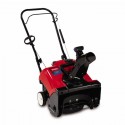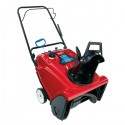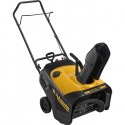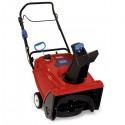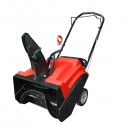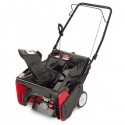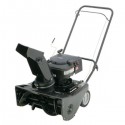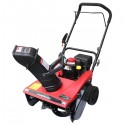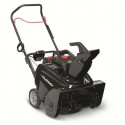Gas Single-Stage Snow Blower Buying Guide
These are the 10 best gas single-stage snow blowers based on product quality, customer satisfaction, and price:
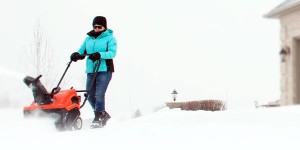 A good snowstorm can be one of the best parts of winter: six or eight inches of snow allows for all kinds of fun winter activities, such as sledding, building snowmen, and making snow forts for snowball fights. But at the same time, it can make the daily routine a bit of a hassle. You will have to negotiate streets that may not be plowed in your car, bundle up before you go outside, and of course, clear snow from your driveway and sidewalk.
A good snowstorm can be one of the best parts of winter: six or eight inches of snow allows for all kinds of fun winter activities, such as sledding, building snowmen, and making snow forts for snowball fights. But at the same time, it can make the daily routine a bit of a hassle. You will have to negotiate streets that may not be plowed in your car, bundle up before you go outside, and of course, clear snow from your driveway and sidewalk.
When you live in a part of the country that gets a fairly good amount of snow every winter, and you have a driveway as well as front walk to keep clear, eventually you will start thinking about purchasing a snow blower. Clearing snow by hand – especially after a big storm that drops more than six or eight inches of snow – can be a big job. And millions of Americans suffer back pain or other health emergencies related to clearing snow each year.
Best single stage snow blowers can power right through snow to get your driveway cleared much more quickly than shoveling snow by hand, and without the hassle of wearing yourself out. Especially if you have a longer driveway, switching over to using a snow blower makes a lot of sense. The amount of time it will save you over the long run is huge, and that means you will be able to get back indoors and out of the cold sooner.
If you have elderly neighbors, owning a snow blower will give you the opportunity to do them a quick favor that they will definitely appreciate. Since clearing snow with a gas powered snow blower is so quick and easy, you can always extend your walk down the street to clear theirs as well. They will thank you for it, and it will not take you much time to do at all.
There are a few different types of snow blowers available, and each one offers slightly different features and advantages. It is important that you learn the differences of each style so that you can select one that is just right for your needs. There are electric and gas powered snow blowers, and there are gas powered snow blowers that are single-stage and two-stage.
In this guide, I will be discussing gas single-stage snow blowers. Their gas-powered augers scoop up the snow and throw it out a chute on the top of the single stage snowblower. These machines are designed to be used on paved surfaces. Because the auger makes contact with the ground, they should not be used on gravel surfaces, as they can pick up and throw stones along with the snow.
Single stage gas snow blowers have auger widths that typically range from about 18 to 22 inches. Their intake height is on the smaller side, and is typically designed to handle about six inches or less of snow. This is usually more than sufficient for the average suburban driveway in the Midwest.
1. Gas Single-Stage Snow Blower is a Good Buyer’s Choice
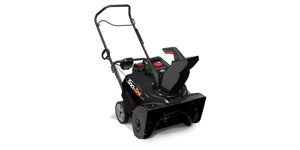 For the average American household that has a driveway that is paved and not more than about 20 yards long, a gas powered single-stage snow blower is a good choice. These machines are designed to handle the kind of snow clearing job that you would expect to find on an average lot size. They have enough power to get the job done quickly and efficiently, their footprint is not so big that they are hard to find storage space for them, and they are durable and heavy duty enough that they will provide reliable performance for several years of normal snowfall. In addition they offer a number of other advantages over other types of snow blowers for the average sized suburban driveway.
For the average American household that has a driveway that is paved and not more than about 20 yards long, a gas powered single-stage snow blower is a good choice. These machines are designed to handle the kind of snow clearing job that you would expect to find on an average lot size. They have enough power to get the job done quickly and efficiently, their footprint is not so big that they are hard to find storage space for them, and they are durable and heavy duty enough that they will provide reliable performance for several years of normal snowfall. In addition they offer a number of other advantages over other types of snow blowers for the average sized suburban driveway.
Some consumers are choosing to go with electric snow blowers, primarily because they want to reduce the carbon emissions their household is producing and improve their environmental impact. This is admirable, but there are certain drawbacks to owning an electric snow blower. And many more consumers continue to choose gas powered snow blowers for a very basic reason. It’s because gas powered snow blowers are strong enough to handle bigger jobs than electric snow blowers can. They can support wider augers, which means you will be able to clear your driveway more quickly with them than with narrower augers on electric snow blowers. And their augers have enough power behind them that they can quickly get through different kinds of snow; even very wet, slushy snow can be cleared more easily with a gas powered snow blower than an electric snow blower.
Gas powered single-stage snow blowers also have higher intake heights than electric snow blowers, which means you will be able to deal with heavier snowfall with a gas powered snow blower. The smaller intake on the electric snow blower will require three or even four trips out to clear the driveway while snow is still accumulating. A gas powered snow blower will let you wait until several inches of snow has fallen before you have to go out and clear it. As a result, you will not have to clear the snow as many times during a storm.
Finally, gas powered single-stage snow blowers have the advantage over electric snow blowers that they have a virtually unlimited range, while the electric snow blower is limited either by the length of your extension cords or the amount of power the battery can hold. If your battery is not fully charged when the snow starts falling, you may be out of luck with your electric snow blower. A gas powered snow blower can be fueled up quickly at any time, so you are never stuck with a dead machine in the middle of a blizzard. And your snow blower’s range is as wide-ranging as your ability to carry a gas can.
Now, for the right kind of household, a single-stage gas powered snow blower has a number of advantages over a two-stage snow blower. The main difference between the two kinds of snow blowers is that a single-stage snow blower only uses the auger to scoop up snow and propel it through the chute, where a dual stage snow blower has an additional part, the impeller. The impeller is like a fan that sucks snow up out of the auger and throws it through the chute. The auger on a single-stage snow blower also makes contact with the ground as it scoops up snow, which helps propel the machine forward at the same time.
As a result, two-stage snow blowers are designed to be more effective on long gravel driveways where you want to avoid having the auger contact the ground. But if you have a typical suburban driveway that is paved with either asphalt or concrete, this simply won’t be a concern of yours. And unless your driveway is more than sixty feet long, the additional width and power of the two-stage snow blower probably won’t be necessary.
For the average suburban household, a two-stage snow blower will be a bit too big for the job at hand. These machines are perfect for rural households that have unpaved driveways, or very large properties with extra long driveways. But if you do not need to address either of these situations, you may find that the two-stage snow blower consumes more fuel than is necessary and has a footprint that makes it unnecessarily difficult to find storage space for it.
If your home is like mine and most other Americans’, with a paved, average-length driveway, then a single-stage gas powered snow blower will be perfect for your needs. You will have the kind of auger width that allows you to get the job done in fewer passes than you could with a smaller electric snow blower, which means you will be back inside and warming up with a cup of hot cocoa all that sooner. Because the auger touches the ground, it not only propels the machine along as it scoops up snow – which will make it easier for you to do the job – it also gives you a very clean surface, which is better looking and safer.
A gas single-stage snow blower is a good buyer’s choice for another reason, too. These machines are significantly less expensive than two-stage snow blowers, which will be welcome news to any of us who have a relatively tight budget for our home and garden upkeep. And because they do not use nearly as much gas as two-stage snow blowers, you will be saving money over the long run as well.
Overall, these are simply great machines that will save you a whole lot of time and energy keeping your driveway and walks clear through the winter. Even if you get snowfall through the whole season, you will be able to quickly and efficiently remove snow as fast as it builds up. A single-stage snow blower is perfect for the average suburban household with a paved driveway that is less than 60 feet long.
2. Gas Single-Stage Snow Blower Buying Specifications
2a. Two cycle or four cycle engine
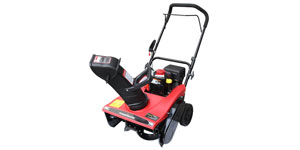 The type of engine you choose to go with depends on a few different factors. A two cycle engine uses a mixture of gas and oil, which supplies both the fuel to run the engine and the lubrication to keep it working smoothly. A four cycle engine has a separate fuel tank for the gasoline and a crank case for the oil. Because of this, two cycle engines require you to add oil, but not change it as frequently as four cycle engines do. Four cycle engines need an oil change after about 24 hours of use, or about once every winter.
The type of engine you choose to go with depends on a few different factors. A two cycle engine uses a mixture of gas and oil, which supplies both the fuel to run the engine and the lubrication to keep it working smoothly. A four cycle engine has a separate fuel tank for the gasoline and a crank case for the oil. Because of this, two cycle engines require you to add oil, but not change it as frequently as four cycle engines do. Four cycle engines need an oil change after about 24 hours of use, or about once every winter.
Of course, changing the oil can be a somewhat messy job, and no one really enjoys having to do it. But four cycle engines have the advantages that they provide superior torque, more efficient fuel economy, cleaner emissions, and an arguably better experience overall. If your driveway is on the longer side of 20 yards, or if your driveway is sloping, you may want to consider looking into a snow blower with a four cycle engine. These will be better equipped to handle bigger jobs than two cycle single-stage snow blowers can. And they can deal with heavier snow as well.
2b. Clearing width and intake height
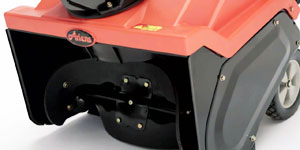 These are two very important specifications when you are shopping for a new snow blower. The clearing width and intake height will determine a number of aspects of your snow blowing experience with a particular machine. The wider the clearing width on the snow blower’s auger, the fewer passes it will take to finish the job. And the fewer passes it takes, the faster you can be done clearing your driveway and back inside the warmth of your home. Nobody likes being outside for more than a half an hour clearing snow, especially when it is bitterly cold out. And it isn’t good for your health, either. So the more quickly you can get the job done, the better.
These are two very important specifications when you are shopping for a new snow blower. The clearing width and intake height will determine a number of aspects of your snow blowing experience with a particular machine. The wider the clearing width on the snow blower’s auger, the fewer passes it will take to finish the job. And the fewer passes it takes, the faster you can be done clearing your driveway and back inside the warmth of your home. Nobody likes being outside for more than a half an hour clearing snow, especially when it is bitterly cold out. And it isn’t good for your health, either. So the more quickly you can get the job done, the better.
The intake height also affects the amount of time you will have to spend outside clearing snow. A shorter intake height means your snow blower will only be able to deal with a smaller snowfall. That means, if you have an intake height that is shorter than the predicted snowfall, you will have to be out there clearing your driveway a few times during the storm as snow accumulates. That is simply unpleasant, and it requires a lot more work than a taller intake height would.
2c. Recoil or electric starter
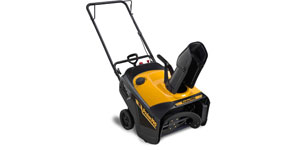 You can choose between recoil or electric starters on a gas powered single-stage snow blower. A recoil starter is one in which you first prime the engine two or three times, hold the clutch in and pull a starter cord to get the snow blower going. With an electric starter, you simply have to turn a key and push a start button, and the majority of electric start snow blowers have to be plugged into an electric outlet while they are being started up.
You can choose between recoil or electric starters on a gas powered single-stage snow blower. A recoil starter is one in which you first prime the engine two or three times, hold the clutch in and pull a starter cord to get the snow blower going. With an electric starter, you simply have to turn a key and push a start button, and the majority of electric start snow blowers have to be plugged into an electric outlet while they are being started up.
If you think you might have trouble using a recoil starter – and some of us do, depending on our strength level, age, or back pain – then an electric starter is a great alternative. But snow blowers with electric starters do tend to be a bit more expensive than those with recoil starters, so be prepared to spend a bit more money if you choose to go with that option. And generally speaking, recoil starters are not terribly difficult to operate, although I can certainly understand those of you who want to avoid being out in a snowstorm while yanking on a recoil starter cord. There is a risk that temperatures will be too cold for electric starters to work, although these machines do come with recoil starters as a backup.
2d. Chute rotation: manual or crank operated
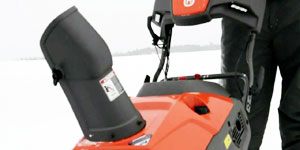 The chute is the part of the snow blower that throws the snow off to the side of the driveway. The chute can be adjusted to throw snow at either a left or right angle as well as out in front of the snow blower. Depending on the width of your driveway, there are different approaches you can take to angling the chute. If your driveway is narrow enough, you can clear snow in a circular pattern from the middle to the edges, keeping the chute in a fixed position while you do so. Or you can clear snow in a back and forth pattern from one end of the driveway to the other. In this case it is better to go up and down the long end of the driveway, and you will have to switch the chute from a left to right orientation.
The chute is the part of the snow blower that throws the snow off to the side of the driveway. The chute can be adjusted to throw snow at either a left or right angle as well as out in front of the snow blower. Depending on the width of your driveway, there are different approaches you can take to angling the chute. If your driveway is narrow enough, you can clear snow in a circular pattern from the middle to the edges, keeping the chute in a fixed position while you do so. Or you can clear snow in a back and forth pattern from one end of the driveway to the other. In this case it is better to go up and down the long end of the driveway, and you will have to switch the chute from a left to right orientation.
The chute can be manually operated or moved around using a crank on the handle. If you have a manually operated chute, you will have to stop the snow blower – and it’s best to turn it off for safety concerns – come around the handle and turn it by hand. If you have a crank operated chute, you can rotate the chute simply by turning the crank. Snow blowers with crank operated chutes are generally a bit more expensive than those with manual chutes.
2e. Wheel size, power, and tire treads
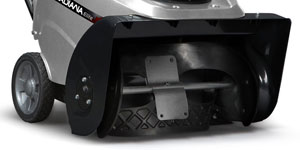 The last fairly important specification to keep in mind when you are shopping for a snow blower is its wheel size, power, and tire treads. Snow blowers with bigger wheels will be able to handle uneven ground more easily, so if the concrete in your sidewalk or driveway is broken up a bit, then a snow blower with bigger wheels will be better. And bigger wheels are also able to offer a bit more in terms of traction and stability.
The last fairly important specification to keep in mind when you are shopping for a snow blower is its wheel size, power, and tire treads. Snow blowers with bigger wheels will be able to handle uneven ground more easily, so if the concrete in your sidewalk or driveway is broken up a bit, then a snow blower with bigger wheels will be better. And bigger wheels are also able to offer a bit more in terms of traction and stability.
While the snow blower’s auger will be what propels single-stage models, the wheels are still important for the snow blower’s ability to maneuver easily. Gear driven wheels are ideal for driveways that slope downhill, as they will be considerably easier to get back uphill. Snow blowers with gear driven wheels will be a bit more expensive than those that do not have a drive mechanism. Tire tread size is another important consideration; wheels that have bigger tire treads will handle icy ground better without spinning or losing traction as easily. Certain snow blowers can also have snow chains attached to the wheels to give them even more traction. This is always a good idea if you live in a region that gets rather heavy snowfall during the winter.
These are the 10 best gas single-stage snow blowers based on product quality, customer satisfaction, and price:

